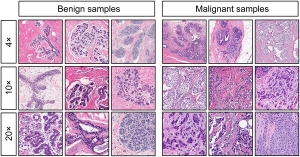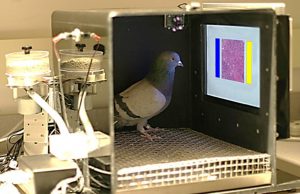Pigeons to Replace Pathologists in Diagnosing Benign from Malignant Tumors
With all the hype and worry over a pathologist shortage in the coming decade, investigators from California, Iowa and Georgia decided to take action and train pigeons to become pathologists.
It turns out that pigeons and pathologists are very similar in many ways but are less expensive to recruit and retain, have a higher reproductive capacity and can work non-stop for days while eating less and working in smaller offices if you are using digital pathology images!
The problem of a worldwide pathologist shortage has been solved! Unfortunately, for radiologists the news is not as encouraging. While pigeon pathologists could identify cancers with 85% accuracy, they are not as accurate with detecting malignant masses on mammograms. So you radiologists cannot give up your days jobs to become pigeon keepers!
Recall from the JAMA Breast Biopsy Study that came out this March, 3 experts agreed with each other 75% of the time after reviewing the slides independently. This was closer to 90% I believe after consensus review. Groups of pigeons were accurate 99% of the time. And these are not even expert pigeons. These are the kind you can find in any major city.
What I am referring to of course is news this week that spread across major media outlets and social media, like, well like, pigeon droppings on a busy city street filled with breadcrumbs.
My favorite title for the news came from NBC News with “Bird Brain? Pigeons Make Good Pathologists, Study Finds“. According to NBC News, “Pigeons can tell the difference between healthy tissue and a tumor, and they might be able to sit in for humans doing some of the more boring chores in a pathology lab, researchers said Wednesday.” Just great.
Drs. Richard M. Levenson, Elizabeth A. Krupinski, Victor M. Navarro and Edward A. Wasserman published their findings this week entitled Pigeons (Columba livia) as Trainable Observers of Pathology and Radiology Breast Cancer Images in PLoS ONE.
To train pigeon pathologists, a team led by Richard Levenson from the University of California Davis Medical Center and Edward Wasserman from the University of Iowa placed pigeons in a conditioning chamber fitted with a touch-screen monitor. Eight pigeons were shown 144 images of benign or malignant tissue samples at three levels of magnification, at different orientations and at different brightness levels. The birds made a diagnosis by pecking on a blue or yellow rectangle on the screen, and they received a tasty treat for each tissue sample they correctly identified.
At the outset, the pigeons were only 50 percent accurate, or simply chance. But after 14 days of training, their accuracy rose to 85 percent. When researchers placed the birds in groups to “vote” on the correct diagnosis — fittingly called “flock sourcing” — pigeons were 99 percent accurate. And just to ensure pigeons’ accuracy wasn’t due to memorization, researchers gave them a set of novel tissue-sample images, and the birds still performed just as well.

Examples of benign (left) and malignant (right) breast specimens stained with hematoxylin and eosin, at different magnifications. Pigeons were initially trained and tested with samples at 4X magnification (top row), and then were subsequently transitioned to samples at 10X magnification (center row) and 20X magnification (bottom row). (Credit: Levenson et al.)
Discover closed their story with this humbling reality by the investigators:
“Still, there’s a larger, philosophical side of this pigeon story. Wasserman and Levenson say this experiment should, perhaps, humble us all a bit. The results of their study indicate that pigeons and humans both rely on similar neurological hardware to interpret the world. In other words, our underlying mechanisms of visual learning appear to be in parallel with a pigeon’s in many ways.
We have utmost respect for dogs’ sophisticated sense of smell; we don’t seem to have trouble believing they can sniff out cancer, for example. But pigeons, the same birds often called “rats with wings,” also deserve higher praise for their skills.
“We should be more appreciative of our fellow inhabitants on the planet. We don’t give them credit for the skills that they do possess,” says Levenson. “This is a tribute to the fact that we’re all in this together and we’re more similar than different in many ways.””
And perhaps some day in the not so distant future pigeons will be used in laboratories to screen our slides. And each pathologist could benefit from a few pigeon colleagues.


































